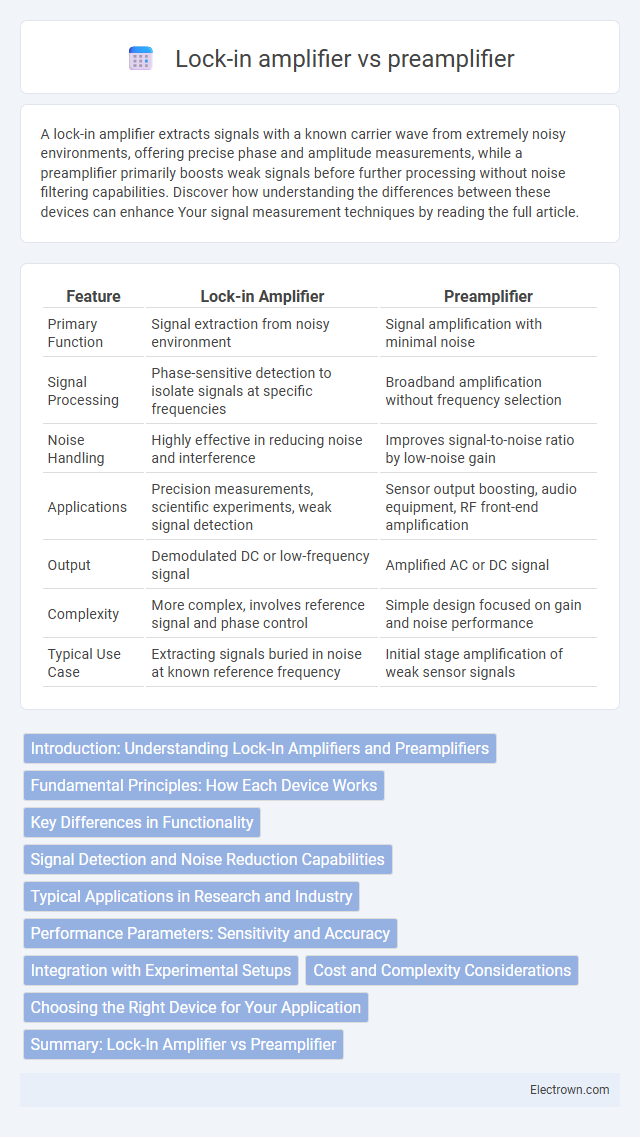A lock-in amplifier extracts signals with a known carrier wave from extremely noisy environments, offering precise phase and amplitude measurements, while a preamplifier primarily boosts weak signals before further processing without noise filtering capabilities. Discover how understanding the differences between these devices can enhance Your signal measurement techniques by reading the full article.
Table of Comparison
| Feature | Lock-in Amplifier | Preamplifier |
|---|---|---|
| Primary Function | Signal extraction from noisy environment | Signal amplification with minimal noise |
| Signal Processing | Phase-sensitive detection to isolate signals at specific frequencies | Broadband amplification without frequency selection |
| Noise Handling | Highly effective in reducing noise and interference | Improves signal-to-noise ratio by low-noise gain |
| Applications | Precision measurements, scientific experiments, weak signal detection | Sensor output boosting, audio equipment, RF front-end amplification |
| Output | Demodulated DC or low-frequency signal | Amplified AC or DC signal |
| Complexity | More complex, involves reference signal and phase control | Simple design focused on gain and noise performance |
| Typical Use Case | Extracting signals buried in noise at known reference frequency | Initial stage amplification of weak sensor signals |
Introduction: Understanding Lock-In Amplifiers and Preamplifiers
Lock-in amplifiers extract signals with known reference frequencies from noisy environments by synchronizing with the input signal's phase, enabling precise measurement of weak signals often in the microvolt or nanovolt range. Preamplifiers boost low-level signals before they reach the main amplifier, improving signal-to-noise ratio and preventing subsequent stage distortion. While lock-in amplifiers provide selective frequency detection and noise rejection, preamplifiers primarily enhance signal amplitude, making them complementary tools in sensitive electronic measurements.
Fundamental Principles: How Each Device Works
A lock-in amplifier extracts signals with a known carrier frequency from an extremely noisy environment by multiplying the input signal with a reference frequency and then applying a low-pass filter to isolate the desired signal's amplitude and phase. A preamplifier boosts low-level input signals to a higher voltage level while preserving the signal-to-noise ratio, minimizing noise introduction prior to further amplification or processing. Lock-in amplifiers rely on synchronous detection principles, whereas preamplifiers focus on linear gain and low noise performance to enhance signal quality before analysis.
Key Differences in Functionality
A lock-in amplifier extracts a specific signal from noisy environments by using phase-sensitive detection, enabling precise measurement of small AC signals with a known reference frequency. A preamplifier, on the other hand, primarily boosts weak signals to higher levels for improved processing without selectively isolating frequencies. Your choice depends on whether accurate signal recovery (lock-in amplifier) or simple signal amplification (preamplifier) is required for your application.
Signal Detection and Noise Reduction Capabilities
Lock-in amplifiers excel in signal detection by extracting signals with a known reference frequency from noisy environments using phase-sensitive detection, achieving high sensitivity to low-level signals. Preamplifiers primarily increase the amplitude of weak signals before further processing, improving signal strength but offering limited noise reduction compared to lock-in amplifiers. The advanced noise reduction capabilities of lock-in amplifiers make them ideal for applications requiring precise measurement of signals buried in noise, whereas preamplifiers serve as initial stages to boost signal levels without significantly enhancing signal-to-noise ratio.
Typical Applications in Research and Industry
Lock-in amplifiers are essential in research fields requiring precise signal extraction from noisy environments, such as in optical spectroscopy, magnetic resonance, and vibration analysis. Preamplifiers are widely used in both research and industry to boost weak electrical signals before further processing, commonly found in sensor interfacing, audio electronics, and medical instrumentation. Their complementary roles enable enhanced signal detection and analysis across physics experiments, biomedical engineering, and industrial measurement systems.
Performance Parameters: Sensitivity and Accuracy
Lock-in amplifiers offer superior sensitivity and accuracy by isolating signals buried in noise through phase-sensitive detection, enabling precise measurement of low-level AC signals. Preamplifiers primarily enhance signal strength with moderate noise reduction, improving sensitivity but generally providing less accuracy compared to lock-in amplifiers. Your choice depends on the need for precise signal extraction in noisy environments versus simple signal amplification.
Integration with Experimental Setups
Lock-in amplifiers seamlessly integrate with experimental setups by selectively amplifying signals at specific reference frequencies, enhancing signal-to-noise ratio in noisy environments. Preamplifiers serve as the initial stage of amplification, boosting weak signals while preserving their integrity before further processing. Your choice depends on whether precise frequency discrimination (lock-in amplifier) or simple signal gain (preamplifier) is required for optimal measurement accuracy.
Cost and Complexity Considerations
Lock-in amplifiers typically entail higher cost and complexity due to their advanced signal processing capabilities, precision phase-sensitive detection, and noise rejection features. Preamplifiers, being simpler devices designed primarily to boost weak signals before further processing, generally remain more affordable and straightforward to integrate within measurement systems. Budget-conscious applications with basic amplification needs often prefer preamplifiers, while precision measurement scenarios justify the investment in lock-in amplifiers despite their higher cost and operational intricacy.
Choosing the Right Device for Your Application
Selecting the right device for your application depends on signal strength and noise level. Lock-in amplifiers excel at extracting weak signals buried in noise by using phase-sensitive detection, ideal for precise measurements in noisy environments. Preamplifiers boost signal amplitude before processing but do not filter noise as effectively, making them suitable when your primary need is increasing signal level rather than noise rejection.
Summary: Lock-In Amplifier vs Preamplifier
A lock-in amplifier extracts signals with a known carrier frequency from noisy environments by using phase-sensitive detection, making it ideal for precise measurement of weak signals. A preamplifier, on the other hand, primarily boosts the amplitude of low-level signals to improve signal-to-noise ratio before further processing. Your choice depends on whether you need targeted noise rejection and phase information (lock-in amplifier) or simple signal amplification (preamplifier).
lock-in amplifier vs preamplifier Infographic

 electrown.com
electrown.com